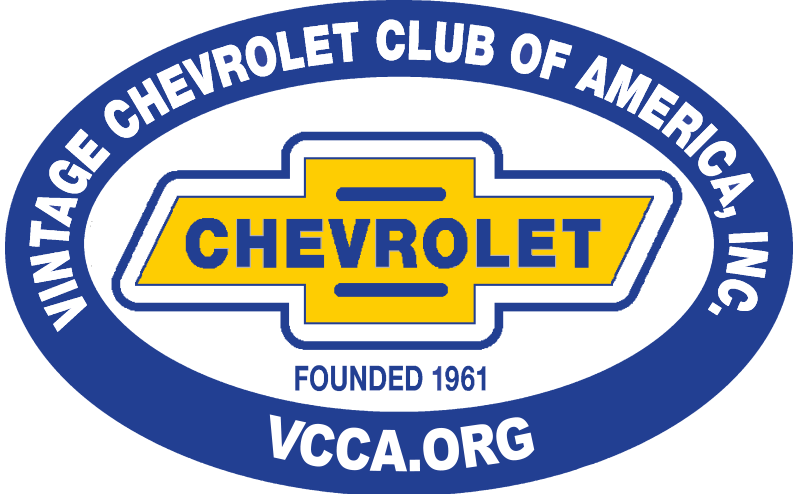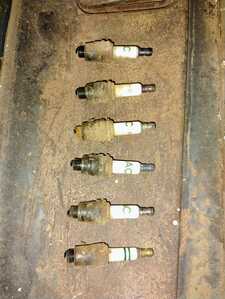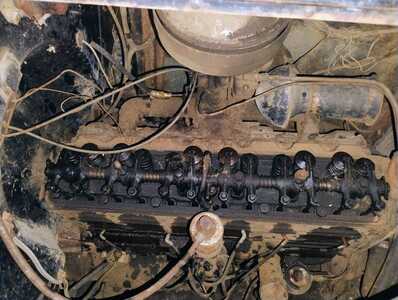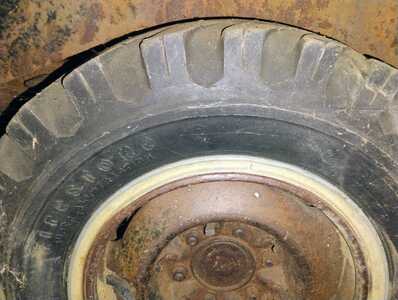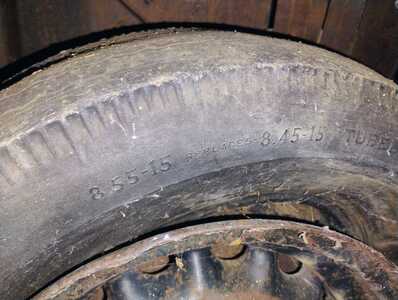To find out if you have a 1941 235 engine, use the casting number, NOT the serial number. Confirm on web page http://home.znet.com/c1937/Cast.htm. The other way to identify a 235 is pull out the dip stick. If the hole is threaded, it's a 235. If it's smooth, it's a 216.
Chevy used a non-syncromesh 4-speed with 6 bolt power take off, from second series 1931 - 1940 and an interchangeable 4-speed from 1941 - 1947. The difference being the earlier trans had one more tooth on low gear giving it 7.22 : 1 in low vs 7.06 in low. http://home.znet.com/c1937/RPM.htm.
@lou-macmillan I appreciate the information, those links seem to be dead for me though.
I'd like to hear thoughts on getting cheap tires for easy loading of the truck.
Can I just get some 5.50 16 tire tubes and stuff them in those tires. Looking to make trailer loading easier.
Learned the gearbox was free when they moved it, Dad was able to get it into N so that was good to hear.
To access the web pages use home.znet.com/c1937/Cast.htm with no period at the end for casting numbers. For transmission and rear end ratios use home.znet.com/c1937/RPM.htm with no period. Your stock rear end ratio is 4.56 : 1 with 9/41 ring and pinion. A half ton rear end with 4.11 gears will bolt in.
Your stock tires are 7.50 X 15". Half ton are 6.00 X 16. One Ton are 7.50 X 17" with 5.14 rear gears.
Glad to hear your trans is working.
7046 old site posts
Save a life, adopt a senior shelter pet
1938 Master Business Coupe
1953 210 Sedan
I'm finally in front of this beauty. Life threw me an opportunity and I ended up getting a job over here in ND and moved to the old farm where this truck is. It's been a crazy 6 months.
Anyways I got in to it today for a bit. Engine still has good looking oil in it which is a plus the big but is the engine is seized up good. Put a bar on the crank and there was no give. Transmission shifts smoothly is another plus.
My thinking is throw white vinegar into each cylinder for a few days of soak. Any suggestions? My thought here is to replace a few lines/ do minimum and just see if I can get it to run before I go pulling everything to rebuild/replace.
I would go with a few ounces of Marvel Mystery Oil in each hole. Let it sit a few days then try working it both directions. If you get some movement put more in and do it again.
7046 old site posts
Save a life, adopt a senior shelter pet
1938 Master Business Coupe
1953 210 Sedan
Putting DOT 3 Brake Fluid in the cylinders works very well. The brake fluid will eat the nasty stuff thats hanging it up. That is if it's just corrosion. I copied that from an internet post but I do know someone who has used it and he said it works very well. As far as the "clean" oil that is not surprising as all the crud has settled in the pan.
7472 old site post
Regarding using brake fluid...
I wouldn't use it myself as anything I've spilled brake fluid on under the hood and not cleaned it off right away rusted like crazy.
Also, we had a brake booster fail and allow brake fluid to be drawn into an engine.
It's pretty hard to get things running well again after that as it sticks valves and makes a really nasty mess of things.
What might work is a mix of acetone and oil.
Apparently the acetone is a smaller molecule than the oil and gets into the tight spots, and then the oil follows.
i haven't had great luck with this when immediate results are wanted, but it may work well if allowed to sit for longer periods.
Ole S Olson
Saskatoon, Sask, Canada
1946 DR 3/4 ton stake
1139 old site posts
North,
I wanted to make sure that you were aware of the Stovebolt.com forum.
I depend on the folks here and the folks there as well for assistance with my 1940 1/2 ton pickup project.
Great folks with a lot of good experience and advice on both sites!
Nick
Nick Gurin
Taos, New Mexico
1940 KC 1/2 Ton Pickup
Thank you for the pointers, I got some marvel mystery oil coming today going to give that a go.
I am aware of stovebolt. I actually started similar article as this one on that site as well : 😁.
@ole-olson I would only use the brake fluid when the plan is to free the engine for COMPLETE REBUILD. The chances of a seized engine being loosed and becoming a GOOD running engine are slim in my opinion.
7472 old site post
Hi Steve
That may indeed be the case here with Nicholas's engine.
But, I've seen several engines carefully broken loose and running fine after a crankcase flush and fresh oil.
Just depends on how badly corroded things are.
For that reason, I think it best to first proceed as if that will be the case.
Otherwise, if it works, go for it. 🙂
Ole S Olson
Saskatoon, Sask, Canada
1946 DR 3/4 ton stake
1139 old site posts
Cylinder 4 is my bugger I think. Can see from the plug it got the most exposed to moisture. I used a cruddy bore scope I have for my phone and could see dead moths sitting in there :D. Looked pretty rusty inside.
All the others looked not half bad. I was rather surprised by the lack of rust in the rocker cover. Even the inside of the cover looked rust free.
Filled each cylinder with a few oz of marvel mystery oil to set. Gonna give it a go on Saturday when I have more time.
I was also able to free up the throttle and choke assembly. Going to dig into air filter as well on Saturday.
Any suggestions for a way to get some cheap tires on this thing? I'd like to get it rolling and trouble shoot the brakes.
Couple pictures of the existing front and back, hoping that will tell someone enough about the rims for some guidance on a cheap way to get it rubber that holds air.
It wouldn't hurt to get some lubrication on the valves and make sure they are not stuck.
Dave
